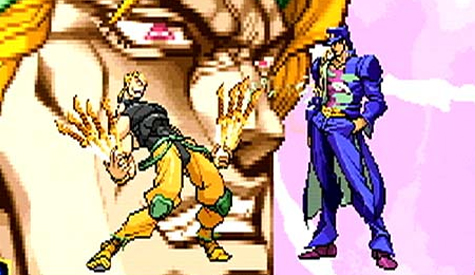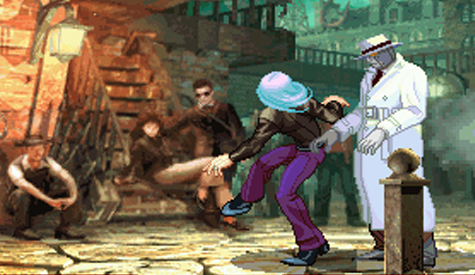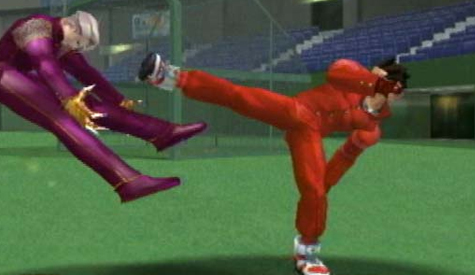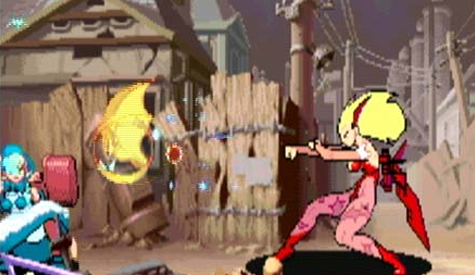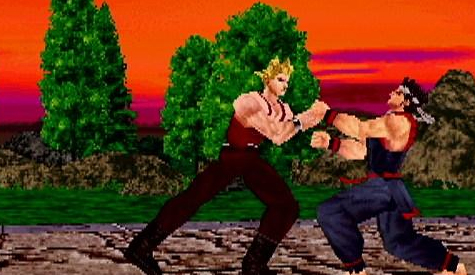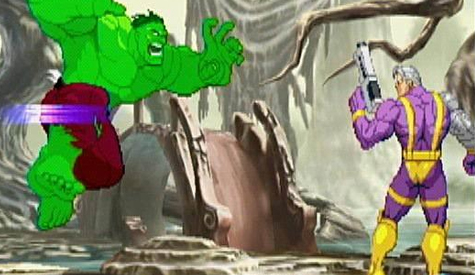It’s the first Sega Addicts Top 10 list of 2012 and we’re starting off big with our top 10 fighting games to appear on Sega consoles! Since the Genesis era, Sega consoles have seen a ton of high quality and unique fighting games released on their systems. From quirky games like Waku Waku 7 to hardcore fighters like the Virtua Fighter series there’s a variety of games with huge and completely different fanbases behind them.
We’ve narrowed that large and diverse list down to the 10 best. Hit the jump to read on.
10. JoJo’s Bizarre Adventure
Josh Newey: It may not be the most balanced or polished fighter featured on the Dreamcast, but Jojo’s Bizarre Adventure is easily one of the most memorable. This achievement isn’t so much due to the game’s impeccable design or technical artistry, but instead to its gorgeous visual style and boundless creativity. Filled to the brim with outlandish character designs like little chihuahuas and screen-filling, over-the-top special attacks like waves of convertible cars jutting out of the ground, Jojo’s Bizarre Adventure is more than happy to bombard its players with an overwhelming cacophony of colorful imagery. Further setting the game apart is the addition of the “Stand Mode,” a special alternate manifestation of each character that affords the player extra offensive and defensive capabilities, intensifying the game’s strategic depth significantly. I may have never been able to really penetrate the game’s difficulty or pick up on its subtle technical prowess, but its unabashed weirdness was undeniably refreshing for its time.
9. Street Fighter 3: Third Strike
Pat Reddick: It’s really no surprise that arguably the best game in the Street Fighter canon made it on this list. It really is a technical achievement for the fighting genre and it continues to impress people today given its recent online rerelease. One problem, however, is the game is so technically amazing that it can be a somewhat alienating experience. But I think there is something good to be said about a game that is so complex it’s hard to play, especially in a list about fighting games.
I think what most people remember Third Strike for over the other two editions of Street Fighter III is its deep roster. Street Fighter III already included a roster of characters that played differently from one another, but Third Strike went all nostalgic on everyone and added Chun-Li to the mix (along with 4 other unique characters). But despite the variance between the characters the game remains well-balanced and a joy to play.
The ever controversial “parry” is in this game as well. Now whether or not you like the parry its legacy and impact on the fighting genre is hard to ignore. Personally, I’m a fan and I don’t think it’s as “broken” as people say it is. I think it helps to make Street Fighter III: Third Strike one of the best tournament fighters ever, and as a result one of the best fighting games ever to grace a Sega console.
8. Project Justice
Flake: Rival Schools is a special mix of Street Fighter, zany Japanese cartoons about high school, and that special stuff that made the 90’s awesome. It is also a forgotten part of Capcom lore. When Darkstalkers fans complain about being ignored they never seem to notice the Rival Schools people glaring at them.
Project Justice is a better-than-perfect port of the arcade sequel to the original Rival Schools. It is full of bright colors, camp, and absurd high-school stereotypes eager to beat each other to a pulp for great justice. With an emphasis on stylish special moves and team work, this is the Capcom fighter for people who got tired of Capcom fighters.
As one of the very last Dreamcast games to see an official release in the States and Europe, it is not the easiest (or cheapest) Dreamcast game to come by. It is worth the effort to obtain, however.
7. Fighters Megamix
Scott Morrison: I bought Fighters Megamix solely because it included two characters from Sonic The Fighters, a game I thought would never see the light of day in the United States. That reason soon became nullified once I discovered I could fight as the Hornet from Daytona USA, the AM2 palm tree logo, and even a slab of meat. Add to that the fact that this game also introduced me to Fighting Vipers and you have my most culturing fighting experience since Street Fighter 2.
Fighters Megamix initially took the Virtua Fighter cast and pit them against the cast of Fighting Vipers. Really though, this game was an excuse to throw in anyone under the sun who could punch or kick in an arena. Janet form Virtua Cop 2 can be pitted against giant-headed Akira from Virtua Fighter Kids. The Hornet Car from Daytona USA literally burns rubber on its opponent’s face after punching with its floating tires. These battles took place in the arena style found in Virtua Fighter or Fighting Vipers, and some characters had armor similar to the Fighting Vipers. The unlockable roster was ridiculously awesome and included a rather extensive method to unlock a few of the fighters ranging from powering the Sega Saturn console on 30 consecutive times, to playing the game for over 80 hours. Even if you have never played a fighting game in your life, Fighters Megamix is a hilarious joyride for any fan of over-the-top video game scenarios.
6. Eternal Champions: Challenge from the Dark Side
Mike Kyzivat: Eternal Champions: Challenge from the Dark side: I know what you’re thinking, what a surprise that not only did Eternal Champions make the list, but Mike is doing the write up for it. There is a reason for that, and that reason is I went completely mental for this game when I first heard they were making a sequel to the Genesis game. Don’t get me wrong, I went nuts for the first game too, but with the announcement of the second game having more characters, levels, and the bloodiest fatalities ever, not to mention CGI intros and cutscenes, I had a full on nerd-gasm. I would collect any magazine that had any kind of information about the game and I would study the pictures in the magazines like I was a CSI investigator. I could not wait for this game.
Now that I’m older, I can say that Eternal Champions is not perfect, but it is a solid game. Way more so than its predecessor. Everything in the Genesis version has been improved. There were no combos in the Genesis release and while the combo system was a little too lenient (some characters could combo the same move over and over) it was leaps and bounds better than the Genesis version. Also, because of the story of the game (which is the most complicated in fighting game history and deals with time travel), you have a very diverse roster of fighters to choose from (24 actually, which was a hell of a lot back then). You want a pirate to face off against a wizard, sure. You want a cybernetic muy thai boxer to fight a cave man, no problem. You want a ninja in lingerie to fight a Pharaoh, ta da!!! You want a Vampire to brawl with a water breathing Atlantian with a trident hand? How many rounds? And each character has a bio that is longer and more complicated than the whole canon of any other fighting game.
Also because of Time travel there are many cool backgrounds to visit, each with not one but two fatalities per stage. Speaking of the fatalities they are waaaaaay gorier then anything that’s been in Mortal Kombat. Including the most recent MK. The game plays more like Street fighter however, but with a little more strategic moves. Moves like reflect projectiles (I believe EC was to first to use this move) force fields with different effects, moves that take away your opponents moves. Not all of them are perfect, or practical, but each character had so many that there were at least 4 to 5 effective moves.
If you listened to the pod cast at all you’ll know I’m very biased about my love for this game, but all fan boy rose colored glasses aside you will not find a SEGA CD game with more stuff jam packed and crammed into it then this game, 24 characters, story mode for each character, many, many CGI cutscenes, Fatalities galore, about (if memory serves) 16 different vs. modes like round robin, see saw, etc., Hidden characters, the list goes on. I’m still finding out new things about this game years later. Just a few years ago I found out you can (with a code at the title screen) see a little slide show of everyone who worked on the game. So even if you don’t run out immediately and buy a copy, especially since you would need a SEGA CD and Genesis, at least watch the fatalities on you tube, that is of course, if you can stomach them.
5. Vampire Chronicle for Matching Service
Kris Knigge: Vampire Chronicle for Matching Service is a very special game. Instead of simply being a compilation of Darkstalkers ports (which would have been fine), Capcom decided that they were going to play around a little bit with this release. While it looks like Vampire Savior (Darkstalkers 3) on the surface, when you choose your character, you have the option to play a version of the character that was roughly equivalent to how they played in the first, second, third (or slightly modified third) game. While playing with Darkstalkers/Vampire mechanics feels rather dated (the way the super gauge worked in that game was always kind of weird), it’s really cool that every single character has four different playable versions to toy around with, even characters who weren’t available in the first two games. Besides, it’s awesome to pit a Vampire Hunter/Night Warriors version of a character against their Vampire Savior incarnation. The additional animations that aren’t in the Saturn version and VGA compatibility make it the best console way to play the (incredibly amazing) Darkstalkers series. Shame it was import-only! (There was later a solid PSP port of Chronicle in English, but it’s just not the same without an arcade stick).
4. Virtua Fighter 2
Tom Kyzivat: You might wonder why I didn’t pick a more recent Virtua Fighter game–the second in the series probably seems kind of archaic by now, and while the newer ones are triumphs in graphics and gameplay, I’ll always have a soft spot in my heart for “The Deuce”. I played the second game more than any other in the series, since its Saturn port was so loyal to the arcade. Sure, the graphics weren’t as crisp, but in pretty much every other aspect it was spot-on.
This game also introduced me the fighting styles of crane and drunken monkey, with their two, new, awesome characters Lion and Shun Di, respectively. I didn’t think it was possible for Sega to add characters that could possibly be as cool as the last set, but these two blew them all away, as I saw it. So much so that every new character they’ve added since has felt decidedly underwhelming. Another reason I liked 2 so much was that it felt much more quintessentially AM2. VF3 retained much of the feel of the first two, but was not as fun, and by the time 4 rolled around, the series felt too plastic and flashy to me. More a bid to mimic Tekken’s overblown style than to keep with its original, traditional martial arts-laden roots. While I enjoy the newer games, VF2 felt like the last true Virtua Fighter, and that’s the one that will always stick with me. Now, aren’t you about ready to go home now?
3. Power Stone 2
Tom Kyzivat: Truth be told, I didn’t actually vote for this game, since I don’t really consider it a traditional fighting game. To me, Power Stone feels more like a mix between a fighting game, a 3D beat’em up and a third person adventure game, but that doesn’t mean it’s not fun. Everything about this game is perfect: unique, fun characters (adding four more from the last), original gameplay, cool weapons and items, and best of all, the ability to transform into a more powerful version of yourself, a la Altered Beast (but without the homo-erotic undertones). This aspect was handled particularly well with this sequel, where they solved a lot of the imbalanced problems that made the first game a simple “first one to jump kick the other and get the stones wins”. Toss in 4-player capability, interactive transforming levels (including four hidden levels), the ability to mix cards to create your own items, two hidden characters, and a surprisingly fun story mode that ended with an awesome boss battle and you hold in your hand a contender for “Best Dreamcast Game EVAH”. It’s nothing short of the efforts of Satan himself that this game hasn’t earned another sequel yet, or at the very least a port to XBLA and PSN. Shame on you, Satan.
2. Soul Caliber
Sven Wohl: Soul Caliber. Also known as: The reason you bought a Dreamcast in the first place. It’s not only a perfect Arcade port; it actually manages to be superior to the Arcade version. The graphics were improved and still look good today. Sure some textures look a bit blurry, but character models, effects and some details are still great to look at. Nintendo 64 games aged way worse! The gameplay is amazing, which is proven by the successors not changing too much. It’s one of the most complete fighting game packages ever, including numerous modes, most importantly a full-fledged quest mode that gives you various objectives for many fights and mixes up things quite well. That puts Capcom’s latest games to shame. This game is still in my Dreamcast and I still play it regularly. It’s easy to learn, hard to master and a lot of fun with friends. One of my favorite fighting games, not only on Sega consoles, but ever!
1. Marvel vs. Capcom 2
John Doherty: I’m a terrible fighting game player. It’s not for a lack of trying either since I’ve played a lot of them. What I love about Marvel VS Capcom 2 is that it’s ok to suck; in fact it may even be better. MVC takes a ton of characters from Marvel, a ton from Capcom, and pits them against each other. It boasts a huge roster of some of the best, and most obscure, characters to come out of their respective universes. It at time trades balance for pure over the top fun in a way that feels fresh and inviting to people who aren’t the best players.
The selling point for me is the fact that instead of picking just one character, you build a team of 3 to use against your enemies. Building new team combinations and finding out how they play off of each other will get you to try every single champion to find out which ones are your favorite. Weaving in the abilities of the fighters you aren’t currently using really opens up the combo system and keeps it nice and flashy.
Speaking of flashy, this game is seriously beautiful. The detailed sprites are not only well drawn, but they are expertly animated as well. It also has such a kooky soundtrack. It’s really jazzy and fits so strangely with games less than hardcore attitude.
This game has time and time again proven to not only be my favorite fighting game on a Sega console, but my favorite fighting game of all time.
How did I go the whole time without making a take you for a ride joke?


